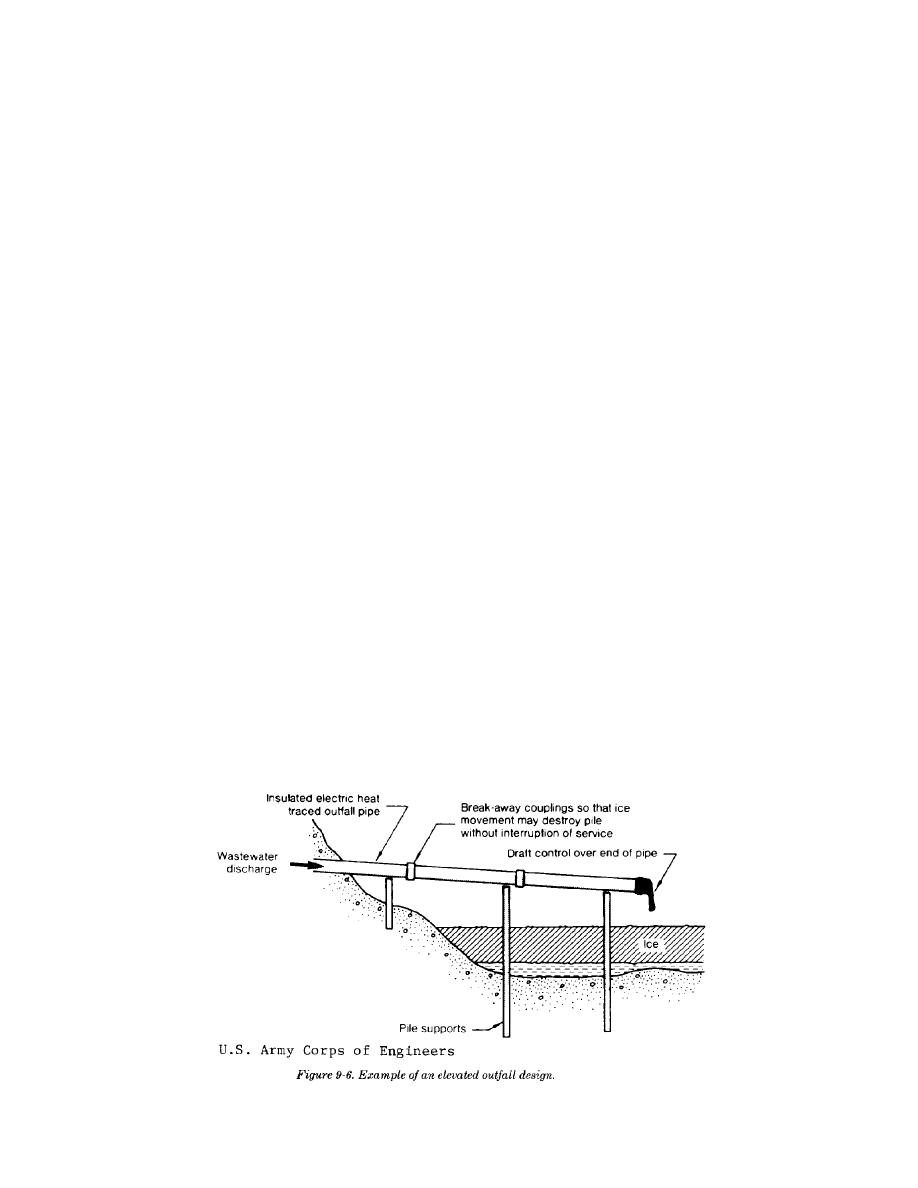
TM 5-852-5/AFR 88-19, Volume 5
(2) Solids concentrations of 20-25 percent
ground prevent surface application or landfill
immediately after thawing are typical and after a few
operations.
more weeks of drying will approach 50 percent. The
9-6. Outfalls.
total depth of sludge that can be frozen is related to
the depth of frost penetration that will occur in a
Outfall structures require special consideration to
particular location. Repeated applications in thin
prevent freezing of the effluent and to prevent
layers is recommended to ensure that each layer
structural damage from ice in the receiving waters.
freezes completely. The following equation can be
In some cases these problems can be avoided by
used to estimate the potential total depth of sludge
designing for seasonal discharge. However, an
that could be frozen (applied in 3-inch layers) if the
unused outfall is still exposed to damage by ice in
maximum depth of frost penetration for a site is
the winter and during spring thaw. Exposed outfall
known:
piping will be insulated and heat-traced. The thermal
'X = 1.76 (fp) - 40
design will be accordance with section 12. A
(eq 9-7)
submerged outfall is recommended wherever pos-
sible. However, in shallow streams the pipe must be
where:
'X = total depth of sludge that could be frozen
protected from ice scour that can occur during
spring breakup. If possible, the pipe will be installed
in 3 inch layers, in.
underground with the outlet completely submerged
Fp = maximum depth of frost penetration for
in water and below the maximum penetration depth
area (see TM-5-852-1/AFR 88-19, Vol.
of winter ice. If these conditions cannot be satisfied
1), in.
an elevated outfall will be required. Figure 9-6
illustrates a typical elevated outfall detail. The
(3) At most facilities it will not be cost-
support piling will be designed in accordance with
effective to depend entirely on freezing since this
TM 5-852-4/AFM-88-19, Chap. 4, to resist the
would require sludge storage during the warmer
uplift forces generated by a floating ice sheet. This
months. The optimum design, to avoid storage, will
is particularly critical at coastal locations with
determine the amount of material that can be frozen
significant tidal action. It is usually not practical to
and then thawed by early summer so that the beds
design simple pile supports to resist the lateral
can be used in the conventional drying mode for the
forces from ice movements during spring breakup.
balance of the warm season. Polymer additions (in
As shown in figure 9-6, break-away couplings will
the summer only) will be necessary to condition
be used to prevent complete destruction of the
alum and other metallic hydroxide sludges for
outfall structure. Elevated outfalls will, in general,
conventional dewatering on the sand beds.
be designed to discharge on top of the ice since an
b. Sludge disposal. Landfills or land application
open water surface cannot always be maintained.
of sludge are the most appropriate techniques for
Most of the effluent will then freeze and form a
disposal in cold regions. Temporary sludge storage
large mound of ice as the winter progresses.
will be necessary where winter conditions or frozen
9-9



 Previous Page
Previous Page
